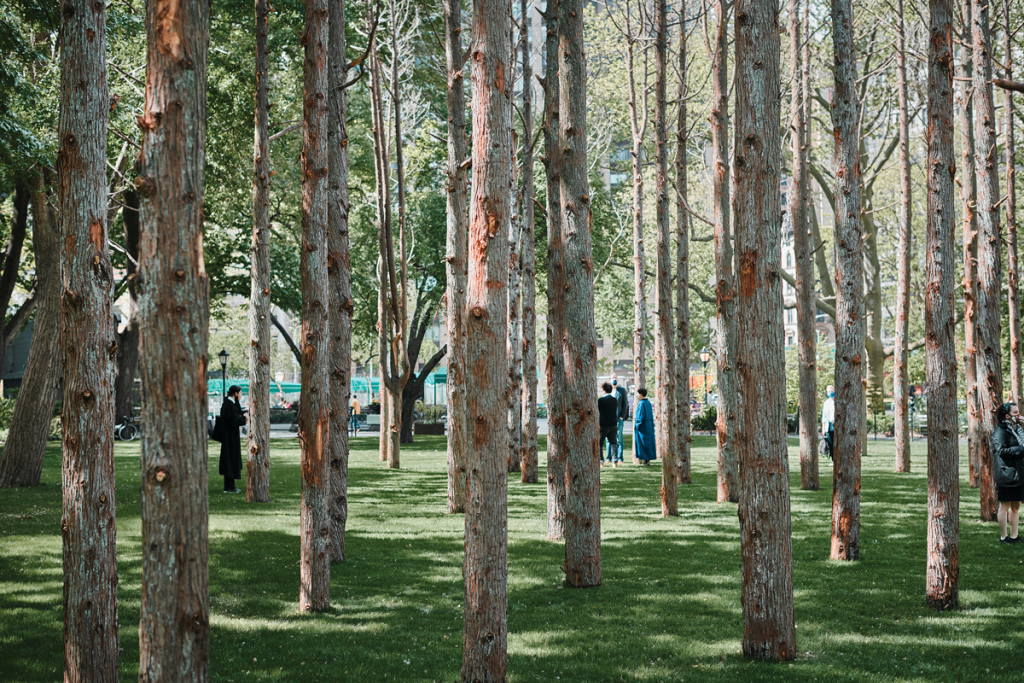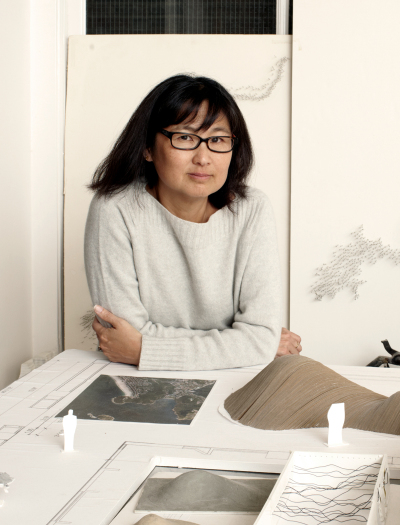 Maya Lin sourced the trees for Ghost Forest from the New Jersey Pine Barrens. Photo Andy Romer/Courtesy the artist and Madison Square Park Conservancy
Maya Lin sourced the trees for Ghost Forest from the New Jersey Pine Barrens. Photo Andy Romer/Courtesy the artist and Madison Square Park Conservancy
So many of us live in cities, and are so removed from nature. I grew up in Athens, Ohio, surrounded by woods. Behind our house were three forested ridges separated by streams; my entire childhood was spent playing in those woods and on those hills. I called the middle one the “lizard’s back” because it started up from the creek bed, like a tail. It grew into a long winding ridge, and ended in what, to my brother and me, looked like the head of a lizard.
My relationship to the natural world was formed playing in those hills, but I was equally influenced in those years by the emergence of the environmental movements that shaped how governments created protections for cleaner air and water, and for endangered species. Growing up, I was extremely aware of how the actions of one species, mankind, was having such a damaging effect on the environment. These sentiments and concerns I still carry with me, but with climate change threatening the planet and us, it has become a more and more urgent issue for me.
What is our relationship to nature in the 21st century, with climate change being one of the greatest threats that we face, and becoming so much a part of how we see the world? And how should we be rethinking our relationship to this world? In my work I find myself intrigued with trying to forge a connection back to the natural world—to maybe get you to pause and listen and take a closer look at what is all around us, things you may not have looked at or listened to since you were a child. My artworks have been shaped by the reactions I have had to the sites they occupy, trying to explore new ways of shifting your perception of the site itself and trying to connect you to your immediate natural environs.
With Ghost Forest in Midtown Manhattan, I am bringing together a need to make you aware of the horrible threats we face due to climate change, and a need to connect you in an intimate and powerful way to the simple yet majestic beauty of nature. I wanted to bring you face to face with these powerful and magnificent trees that grow so near Manhattan—they come from New Jersey—and that are rapidly disappearing. They form a silent grove that bears witness to the immense and almost incomprehensible global forest die-off, and yet there is a haunting beauty to them. I see them as silent gentle giants that I am asking you to get to know.
 Maya Lin. Photo Jesse Frohman
Maya Lin. Photo Jesse Frohman
I started my career working with themes of memory and loss, and I have throughout my life been drawn to continue with these memory works, while still pursuing both my art and architectural practices. With Ghost Forest I was able to create something that is an environmental sculptural artwork as well as part of a more advocacy-driven project of mine, What Is Missing?, a memorial devoted to raising awareness about what we are losing from the natural world that also emphasizes what can be done to help both protect and restore species and habitats as well as reduce climate change emissions.
Throughout the world, climate change is causing vast tracts of forest to die. These are called ghost forests, and they are being killed off by rising temperatures, deforestation, saltwater inundation as seas rise, forest fires, and insects whose populations are thriving in these warmer temperatures; the trees themselves are more susceptible to beetles due to being overstressed from rising temperatures. In Southwestern Colorado, where my family and I live in the summer, the national forest lands show evidence of beetle infestation one season, with upper needles turning reddish brown, and by the next season the entire stand has died.
As I approached thinking about a sculptural installation for the Madison Square Park Conservancy I knew I wanted to create something that would be intimately related to the park itself, the trees, and the state of the earth. Being more accustomed to making permanent large-scale works, I knew a different approach had to be taken, that I wanted to create something transient and temporal rather than a work that felt more like one of my permanent pieces. It is not a time frame I am familiar with in my outdoor installations.
Planting trees was an idea that seemed to fit the temporality of the project. As I was thinking about how to approach this project and site, I could not stop looking at the ghost forest right outside my studio in Colorado, which looks out onto those national forest lands. I felt I needed to bring a ghost forest to the heart of Manhattan, and to find trees that were as close to Manhattan as I possibly could find.
My team and I located trees in the Pine Barrens of New Jersey: 150 miles from the city, a stand of Atlantic cedars was dying due to saltwater inundation from a nearby estuary. Foresters were working with the local landowner to clear this dying grove as part of a forestry practice that will allow for the regeneration of the trees, since cedars need open light to repopulate. We are “borrowing” these trees for the 6-month installation—and this grove will continue to decay and bear witness to the full seasonal cycle of the living trees in the park.
I believe raising awareness is critical to get people to want to act, but I also feel strongly that climate change is happening so rapidly that it is not enough to just wake people up to the problems we face. I believe it’s important to focus equally on what each one of us can do to help. A main cause of emissions, and a driver of species loss is our land use practices. Reforming our forestry practices, reforming our agricultural and ranching practices, and protecting and restoring our forests, grasslands, and wetlands—these nature-based solutions can potentially offset and sequester significant amounts of the world’s emissions (50–90 percent). They would not only help protect earth’s biodiversity, but also ensure that it is increased and restored.
 Lin has created three undulating Wavefield pieces, the first two for sites in Ann Arbor, Michigan, and Miami, Florida. The third—and largest—is pictured here, at Storm King Art Center in Upstate New York. Photo Jerry Thompson/Courtesy Storm King Art Center
Lin has created three undulating Wavefield pieces, the first two for sites in Ann Arbor, Michigan, and Miami, Florida. The third—and largest—is pictured here, at Storm King Art Center in Upstate New York. Photo Jerry Thompson/Courtesy Storm King Art Center
As part of Ghost Forest, and in conjunction with the Natural Areas Conservancy, a thousand trees and shrubs will be planted to offset the carbon emissions produced in the making of the artwork—throughout the 3 years of planning and installation we were able to calculate our carbon footprint. Approximately 5.3 tons of carbon were emitted, and over the course of 10 years those thousand trees will absorb some 60 tons of carbon, more than offsetting the artwork’s carbon output.
Ghost Forest is the latest installation of what I see as my fifth and final memorial, What Is Missing?, a nonprofit foundation that I established to raise awareness of the ongoing sixth mass extinction, focusing attention on species and places that have gone extinct or will most likely disappear within our lifetime if we do not act to protect them. Critical to the foundation’s mission is not just making you aware of what we are losing, but emphasizing that by protecting and restoring habitats and reforming our land use practices we can effectively “save two birds with one tree”—both protect species and reduce emissions.
Like my other artworks, What Is Missing? (and Ghost Forest as a part of it) is about nature and our relationship to it, focusing on what we are losing in the natural world as well as presenting both specific actions we each can take to help as well as envisioning new macro ways to see a different outcome for us and for our planet. I see the overall concept as a guerrilla science–based art project that continues to grow and evolve: I am building this memorial in plain sight and revising it as I go. What Is Missing? is a memorial that can exist in multiple forms and places; Ghost Forest is, so far, the most visible manifestation of it.
This past spring, when Ghost Forest opened, marked the soft launch of our revamped website for What Is Missing?, whatismissing.org, with a more public launch planned for the fall. As with so many of my works, time is very much the framework for this memorial. What Is Missing? presents an ecological history of the planet: past, present, and future. What we are losing or have lost, stories of conservation successes and failures occurring right now, and, finally, greenprint, which presents macro thinking about plausible future scenarios that will balance our needs with those of the planet.
I believe that art can help us imagine and map sustainable future scenarios, and, in doing so, give people a way to see and hope for a different future. I think people are overwhelmed by the problems we face, and feel helpless. What Is Missing? demonstrates how each person’s actions can make a difference, and how art can at times present new ways of looking at the problems we face in a way that makes those problems feel scalable. It can help us see how much of a difference our actions can make.
One part of the website asks visitors to share a personal memory of something they have witnessed diminish or disappear from the natural world. In so doing, they become a part of this growing online collective memorial, and perhaps also reconnect to nature. I invite you too to contribute.
Source link : https://www.artnews.com/art-news/artists/maya-lin-environmentalism-ghost-forest-1234602124












